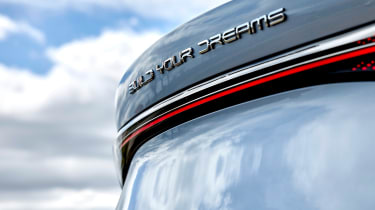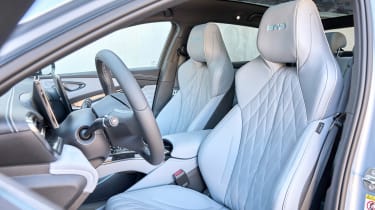New BYD Seal 2023 review
BYD further expands its UK model offering with the Seal, a well-rounded, realistic rival for Tesla’s Model 3
Verdict
A definitive verdict on the Seal must wait until UK prices are confirmed, but our short drive has given us no reason to downgrade its star rating from when we tried a car in China last year. Assuming that BYD does throw the Seal in between the Model 3 and the Ioniq 6 on price, it definitely feels up to taking both of these (very competent) rivals on – not just on value, but also on performance, interior finish, practicality and kit.
Things happen pretty quickly at BYD. The world’s second-largest battery manufacturer only launched its first Europe-targeted car last year, in the form of the Atto 3. But even as the small SUV goes on sale in a small number of dealerships in the UK (a few months after BYD’s original target), there are two further new vehicles to try – the smaller Dolphin, and the range-topper, the Seal.
While the Atto 3 is aimed at the likes of the VW ID.3 and even the MG 4, the Seal is clearly BYD’s best crack yet at a proper competitor for the Tesla Model 3 (and, by inference, Hyundai’s latest Ioniq 6). It has an aerodynamic saloon body style and sits on BYD’s latest ‘e-Platform 3.0’ architecture, using the firm’s ‘blade’ battery configuration – in this case, coupled with tech whereby the cells themselves are stitched into the construction of the vehicle, saving space normally taken up by packs.
The Seal is notably longer than the Atto 3, and indeed the Model 3, at 4.8 metres. It has a wheelbase of 2,920mm, over five centimetres longer than the Tesla’s, and its boot capacity is a reasonable 402 litres – or a Model 3-beating 455 litres when the underbonnet storage area is taken into consideration.
There will be a couple of technical specifications to choose from. The rear-wheel-drive version has 308bhp, a 0-62mph time of 5.9 seconds and an 82kWh (usable) battery that can deliver 354 miles of range.
Above this, there’s a four-wheel-drive dual-motor edition that’s set to take on higher-powered Model 3s, as well as the inevitable future N-badged version of the Ioniq 6. It has two motors with a combined output of 523bhp, and can reach 62mph in 3.8 seconds. Its battery capacity is the same, but the extra shove cuts range to 323 miles.
Regardless of motor configuration, European Seals get 150kW DC charging that can take the battery from 30 to 80 per cent of its capacity in 26 minutes. Three-phase 11kW AC charging and a heat pump come as standard, too.
Our first taste of the Seal comes in rear-drive spec, and over a slalom course laid out at a Spanish race circuit. From the first few yards, it’s clear that the firm is setting its sights high – body roll is well contained, the steering feels direct and the throttle-pedal modulation is nicely judged and linear.
We’re in the rear-drive car and even with a kerbweight that has to be approaching two tonnes, the motor’s instant punch is more than capable of making the Seal feel brisk. The track surface beneath us is billiard-table smooth, so it’s hard to judge any trade-off in ride quality, but the car shows direct steering response and a willingness to change direction quickly without much complaint.
A subsequent squirt in the four-wheel-drive version reveals that it does have appreciably more shove – the combined torque of the two motors is said to be around 670Nm – and a little more agility, helped by torque vectoring. But we wouldn’t say the rear-drive version feels like a much poorer cousin, on dynamics at least.
Inside, there’s BYD’s latest infotainment system, based on a hefty 15.6-inch display that dominates the fascia. It can rotate between portrait and landscape layouts, too, mimicking the party piece of the Atto 3’s screen – though the jury’s still out on how useful this feature actually is in everyday use.
The interface is slightly haphazard, with some small graphics; it still looks like a no-brand Android tablet grafted onto the dash, instead of a system properly tailored to in-car use. But it’s powerful enough beneath the skin, ensuring quick responses to screen prods – just as well, really, since most of the car’s systems, including the heating and ventilation, are controlled in this way.
This overpowering tech – and a scattergun approach to typeface consistency across the screens and buttons – are probably the biggest pointers to the car’s Chinese origins, in fact, because the rest of the cabin feels every bit a proper £45,000 vehicle. There are padded surfaces in all of the right places and there’s greater sophistication here on materials – double-stitched fabrics, textured plastics and so forth – than we’ve seen so far in BYD’s other two UK-bound offerings, the Atto 3 and Dolphin.
There’s plenty of space, too, for four grown-ups – and a flat floor that means a fifth occupant can squeeze into the middle-rear seat without too many grumbles. The legroom in the rear is more impressive than the headroom – taller passengers may find their hairline disappearing into the cutout for the (admittedly spectacular) panoramic glass roof - but if anything, it feels more spacious in the rear of the Seal than it does in the Ioniq 6.
| Model: | BYD Seal |
| Price: | From £41,000 (est) |
| Powertrain: | 1x e-motor, 82kWh batt. (net) |
| Power: | 308bhp |
| Transmission: | Single-speed automatic, rear-wheel drive |
| 0-62mph: | 5.9 seconds |
| Top speed: | 112mph |
| Range: | 354 miles |
| Max charging: | 150kW (30-80% in 26min) |
| On sale: | Autumn |
Now read our in-depth review of the BYD Seal's arch-rival, the Tesla Model 3...





